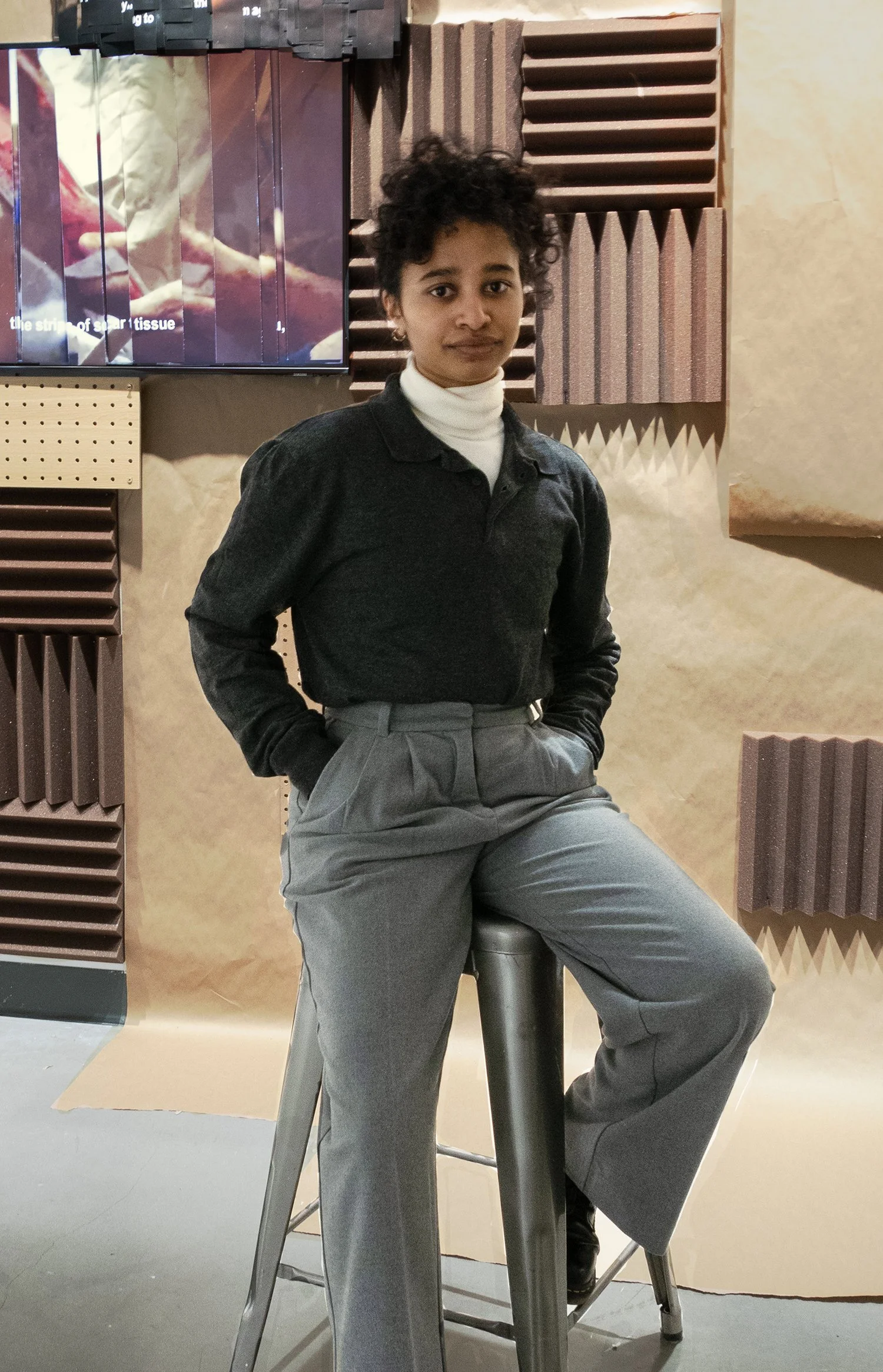A Q&A with 2024 Summer Archivist Fellow: Morisha Moodley
Shanley Poole: For starters, can you tell us a bit about yourself?
Morisha Moodley: I [was] the Archive and Historic Preservation Fellow for the summer. I came to Ox-Bow right after completing my MFA in Art, Theory and Practice at Northwestern University.
I’m a moving image artist who works across video, text, and installation. In my art practice, I’ve worked with digital archives before to source videos and research material. So my interest in the archive and the stories it has to offer has grown steadily.
I was drawn to this position at Ox-Bow because I wanted to learn more about archive and preservation processes. This [was] the first time I’ve physically handled materials from an archive and been involved in the digitisation process.
Moodley’s work on display at the 2024 Summer Fellows Exhibition. Photo by Dominique Muñoz (Summer Fellow, 2024)
SP: What did your work in the archives look like [last] summer?
MM: As Ox-Bow doesn’t have an Archive department (yet!) I [did] some foundational work in terms of organizing and digitizing. My focus [was] on the collection of catalogs Ox-Bow has, dating from its early days in the 1910s until now. The first part of my summer was going through the many, many banker boxes that house all of the archival material. These are currently in Ox-Bow House, Ox-Bow’s satellite location in downtown Douglas.
I went through everything that was available, collating the catalogs and picking up any memorabilia that I thought could help me piece together an idea of the faculty and educational offerings that Ox-Bow has provided in its 100+ years of history.
After that initial organization, I began the slow process of digitizing, setting up new systems of grouping information, and transcribing information in the catalog to our database.
SP: Were you able to glean any perspectives on Ox-Bow from the content that was in the catalogs?
MM: It’s one thing to know that women have long since been students at Ox-Bow, but to know, as was highlighted in the Summer 2023 exhibition, that they also had a hand in shaping the atmosphere, the education opportunities, and the overall direction of the School was also incredible. In a time when women were fighting for their rights and voices to be heard, to see them have real, ongoing effect on an organization like Ox-Bow, is a really powerful example of their capabilities and potential.
A glimpse into the 2023 exhibition She Started It. Photo by Natia Ser (Summer Fellow 2023).
I’ve also been interested in the appearance of BIPOC artists at Ox-Bow that started around the 40s. BIPOC artists have been involved in the school from that time in different capacities from teaching classes, acting as Visiting Artists, and being residents. Whilst the artists in the 40s seem to be rarities and were really exciting finds, from the 80s onwards there are usually one or two POC artists appearing every year. This feels reflective of the way the Art World in that period was also starting to encourage underrepresented voices. I think it’s especially interesting to see this welcome of diversity at Ox-Bow because it is, and definitely was at that time, a very small organization in a very rural area. When I think of diversity, I usually think of it existing in more metropolitan regions. To know that Ox-Bow had opened its arms to more diverse groups has made me intrigued about other spaces in small towns that could have also been accepting of different cultures, and I am curious to know what the artists’ experiences were like at the time.
SP: What were some of the names you found?
MM: Leroy Neiman, Carlos Lopez, Arthur Okamura, Fay Arrieh Frick, Takeshi Takahara, Johnnie Johnson and Martin Puryear. Puryear’s work was especially exciting to find. I love how you can really see his background in traditional craft techniques like weaving and furniture-making in the pieces. With his sculptures that look like armatures rather than ‘finished’ works, the process of making and that hint of tradition is really brought to the fore.
SP: Are there any mysteries or loose ends that you wish you could get to the bottom of?
MM: As I mentioned, the experiences of BIPOC at Ox-Bow would be fascinating to know, especially in earlier decades.
Having never been to Saugatuck before, I was really surprised to find out that it is a renowned queer-friendly destination, and especially is seen as the gay, summer hub of the Midwest. I would love to know more about how Ox-Bow has contributed to this scene or grew to be a part of it. In an article I’ve read, it suggests that when the “artsy” types at Ox-Bow started to move in, it also helped for more queer artists and art lovers to feel comfortable in this small Midwest town.*
When I came to Ox-Bow, on the very first day, I realized that this was a queer space and a safe space. So, I’d love to know more about that history and how it came to be. When I’ve done research into some of the faculty and visiting artists, it has been really difficult to glean whether they were part of this Queer migration or community. There’s sometimes so little info about artists and creatives who came—some seem to only exist in our catalog materials!—that [it was] difficult in the short span of time I [was] here to dig deeper and find those connecting threads. So, that is one loose end, and one that I hope someone will have the time to weave with.
*Michigan Public NPR, ”How the largest gay resort in the Midwest is in Michigan's "Bible belt," January 11, 2016.
Morisha Moodley (b. Durban, ZA) is a London and Chicago-based moving image artist who works across video, installation, and text, examining the entanglement of race, queerness, disability, and theology through these forms. Their practice is rooted in research of the moving image. To this, they interject queer and crip methodologies that challenge traditional film structures. Their work has been screened and exhibited internationally, including at London Short Film Festival, Kasseler Dokfest, Alchemy Film and Moving Image Festival, Global Citizen, and Camden Art Centre. Morisha is a recipient of a Develop Your Creative Practice grant from Arts Council England, AfA’s micro-grant, and was awarded the Northwestern University Fellowship to attend the 2023 Flaherty Film Seminar. They graduated from Central Saint Martins with a First in BA (Hons) Fine Art and from Northwestern with an MFA in Art, Theory and Practice.
This interview was facilitated by Shanley Poole, Engagement Liaison and Storyteller, using Ethical Storytelling practices. It was originally published in the 2024 Experience Ox-Bow Catalog.
Banner image: Archive materials featured in the 2023 exhibition She Started It. Photo by Natia Ser (Summer Fellow 2023).




